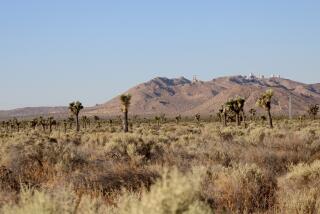A solar plant worth its salt
- Share via
Just past Barstow on Interstate 15, Las Vegas-bound travelers can eye a tower resembling a lighthouse rising out of the desert encircled by more than 1,800 mirrors the size of billboards.
The complex is often mistaken for a science fiction movie set, but it is actually a power plant that once used molten salt, water and the sun’s heat to produce electricity.
Now a storied rocket maker in Canoga Park and a renewable energy company in Santa Monica are hoping to take what they learned at the long-closed desert facility to build a much larger plant that could power 100,000 homes -- all from a mix of sun, salt and rocket science once believed too futuristic to succeed.
The Santa Monica-based energy firm SolarReserve has licensed the technology, developed by engineers at Rocketdyne.
“Molten salt is the secret sauce,” said SolarReserve President Terry Murphy.
It is one of at least 80 large solar projects on the drawing board in California, but the molten salt technology is considered one of the more unusual and -- to some energy analysts -- one of the more promising in the latest rush to build clean electricity generation.
“It’s actually something we’ll likely see in a few years,” said Nathaniel Bullard, a solar energy analyst with New Energy Finance in Alexandria, Va. “It’s moving along in a nice way, and they have good capital behind it.”
SolarReserve, which is financing and marketing the project, said it is working on agreements with several utilities to buy electricity generated from the plant. It hopes to have several announcements in a few months that could help jump-start construction of the first plant, which would probably be on private land in the Southwest, Murphy said.
The company last fall secured $140 million in venture capital.
The plant could begin operating by early 2013. It would use an array of 15,000 heliostats, or large tilting mirrors about 25 feet wide, to direct sunlight to a solar collector atop a 600-foot-tall tower -- somewhat like a lighthouse in reverse.
The mirrors would heat up molten salt flowing through the receiver to more than 1,000 degrees, hot enough to turn water into powerful steam in a device called a heat exchanger. The steam, like that coming out of a nozzle of a boiling tea kettle, would drive a turbine to create electricity.
The molten salt, once cooled, would then be pumped back through the solar collector to start the process all over again. “The plant has no emissions, and if you have a leak or something, you can just shovel it up and take it home with you to use for your barbecue,” Murphy said.
The molten salt can be stored for days if not weeks and then used to generate electricity at any time. Many other solar technologies work only when the sun is shining. Storing electricity in a battery works for cars and homes but not on a massive scale that would be needed to power thousands of homes.
“You can put that into a storage tank that would look much like a tank at an oil refinery,” Murphy said. “We can store that energy almost indefinitely.”
While there are high hopes for the technology, some environmentalists have criticized solar-thermal plants for requiring vast tracts of land as well as precious water for generating steam and for cooling the turbines.
The array of the mirrored heliostats for the SolarReserve plant would take up about two square miles. Transmission lines would also be needed to transport the power where it’s needed. With dozens of solar, wind and geothermal projects planned for California’s deserts, some fear that this unique habitat will be destroyed.
But SolarReserve officials said that the plant would use one-tenth the amount of water required by a conventional plant and that mirrors will be “benign” to the environment.
The technology, with the exception of using salt, is similar to those that Rocketdyne engineers developed for the nation’s more notable space programs.
At the sprawling Canoga Park facility, the engineers who came up with the SolarReserve technology also developed the power system for the International Space Station, the rocket engine for the space shuttle, and the propulsion system for the Apollo lunar module.
Rocketdyne’s aerospace heritage stretches back to the earliest years of rocket development, when it was founded shortly after World War II to study German V-2 rocket technology. After becoming part of Rockwell International in the late 1960s, the company was sold to Boeing Co. in 1996.
United Technologies bought the Rocketdyne unit from Boeing for $700 million in 2005 primarily for its expertise in rocket engines. It didn’t know about the solar project until after the acquisition.
Now Rocketdyne believes it can generate $1 billion in revenue from making the components for the plant, including the tower that would collect the sun’s concentrated heat from thousands of mirrors.
The solar collector in many ways is similar to the inside of a rocket nozzle that has to withstand thousands of degrees of heat, said Rick Howerton, Rocketdyne’s program manager for concentrated solar power who previously worked on the space station program.
The solar-thermal technology was proved workable more than a decade ago at the Barstow pilot plant. But the complex was shuttered in 1999 when the cost of natural gas fell to one-tenth of what it is today.
Also there wasn’t as much concern for the environment then, Murphy said. “It was ahead of its time. The market hadn’t caught up to it.”
--
More to Read
Inside the business of entertainment
The Wide Shot brings you news, analysis and insights on everything from streaming wars to production — and what it all means for the future.
You may occasionally receive promotional content from the Los Angeles Times.










